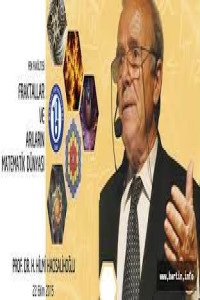Abstract
In this study, a different geometric model that is thought to be used in teaching derivatives and integrals will be introduced. This geometric model is based on the meanings of the words derivative and integral. The geometric models used for teaching consist of plane geometric regular shapes. With this study, whether this geometric model should be used in teaching derivatives and integrals, its deficiencies or incorrects will be opened to discussion by mathematics and mathematics educators.
References
- Abramovich, S., & Norton, A. (2006). Beyond the black box: Calculus teaching in dynamic computer environments. Educational Studies in Mathematics.
- Artigue, M. (2000). Teaching and learning calculus: What can be learnt from education research and curricular changes in France? CBMS Issues in Mathematics Education, 8, 1–15.
- Duval, R. (2006). A cognitive analysis of problems of comprehension in a learning of mathematics. Educational Studies in Mathematics, 61(1), 103–131.
- Freeman, S., et al. (2014). Active learning increases student performance in science, engineering, and mathematics. Proceedings of the National Academy of Sciences.
- Heid, M. K. (1988). Resequencing skills and concepts in applied calculus using the computer as a tool. Journal for Research in Mathematics Education.
- Hohenwarter, M., & Fuchs, K. (2004). Combination of dynamic geometry, algebra, and calculus in the software system GeoGebra. Computer Algebra Systems and Dynamic Geometry Systems in Mathematics Teaching Conference.
- Hohenwarter, M., & Preiner, J. (2007). Dynamic mathematics with GeoGebra. Journal of Online Mathematics and its Applications.
- Kaput, J. J. (1994). The representational roles of technology in connecting mathematics with authentic experience. In R. Biehler, R. W. Scholz, R. Strasser ve B. Winkelman (Eds.), Didactics in Mathematics as a ScientificDiscipline, 379-397. Netherlands: Kluwer Academic Publishers.
- Keller, B. A., & Hirsch, C. R. (1998). Student understanding of the integral concept in calculus. Educational Studies in Mathematics.
- Khan, S. (2012). The One World Schoolhouse: Education Reimagined. Twelve.
- Konyalıoğlu, A. C., Kaplan, A., Selvitopu, H., Işık, A. and Tortumlu, N.(2011a). Some determination on conceptual learning of the derivative concept. Journal of Kazım Karabekir Education Faculty. (22).317-328.
- Konyalıoğlu, A. C., Tortumlu, N, Kaplan, A., Işık, A..& Hızarcı, S.(2011b). On Pre-Service Mathematics Teachers’ Conceptual Understanding of The Integral Concept. Journal of Bayburt Education Faculty. 6(1). 1-8.
- Orton, A. (1983). Students’ understanding of differentiation. Educational Studies in Mathematics, 14(3), 235–250.
- Prince, M., & Felder, R. (2006). Inductive teaching and learning methods: Definitions, comparisons, and research bases. Journal of Engineering Education.
- Stewart, J. (2012). Calculus: Early Transcendentals. Cengage Learning. Tall, D. (1993). Students' difficulties in calculus. In Proceedings of Working Group 3 on Students’ Difficulties in Calculus (pp. 13–28).
Abstract
Bu çalışmada, türev ve integral öğretiminde kullanılabileceği düşünülen farklı bir geometrik model tanıtılmaya çalışılacaktır. Bu geometrik model türev ve integral kelimelerinin anlamları üzerine kuruludur. Öğretim için kullanılan geometrik modeller ise düzlem geometrik düzgün şekillerden ibarettir. Bu çalışma ile, bu geometrik modelin türev ve integral öğretiminde kullanılıp kullanılmaması durumu, eksik ya da hatalı yönleri matematik ve matematik eğitimcilerinin tartışmasına açılacaktır.
References
- Abramovich, S., & Norton, A. (2006). Beyond the black box: Calculus teaching in dynamic computer environments. Educational Studies in Mathematics.
- Artigue, M. (2000). Teaching and learning calculus: What can be learnt from education research and curricular changes in France? CBMS Issues in Mathematics Education, 8, 1–15.
- Duval, R. (2006). A cognitive analysis of problems of comprehension in a learning of mathematics. Educational Studies in Mathematics, 61(1), 103–131.
- Freeman, S., et al. (2014). Active learning increases student performance in science, engineering, and mathematics. Proceedings of the National Academy of Sciences.
- Heid, M. K. (1988). Resequencing skills and concepts in applied calculus using the computer as a tool. Journal for Research in Mathematics Education.
- Hohenwarter, M., & Fuchs, K. (2004). Combination of dynamic geometry, algebra, and calculus in the software system GeoGebra. Computer Algebra Systems and Dynamic Geometry Systems in Mathematics Teaching Conference.
- Hohenwarter, M., & Preiner, J. (2007). Dynamic mathematics with GeoGebra. Journal of Online Mathematics and its Applications.
- Kaput, J. J. (1994). The representational roles of technology in connecting mathematics with authentic experience. In R. Biehler, R. W. Scholz, R. Strasser ve B. Winkelman (Eds.), Didactics in Mathematics as a ScientificDiscipline, 379-397. Netherlands: Kluwer Academic Publishers.
- Keller, B. A., & Hirsch, C. R. (1998). Student understanding of the integral concept in calculus. Educational Studies in Mathematics.
- Khan, S. (2012). The One World Schoolhouse: Education Reimagined. Twelve.
- Konyalıoğlu, A. C., Kaplan, A., Selvitopu, H., Işık, A. and Tortumlu, N.(2011a). Some determination on conceptual learning of the derivative concept. Journal of Kazım Karabekir Education Faculty. (22).317-328.
- Konyalıoğlu, A. C., Tortumlu, N, Kaplan, A., Işık, A..& Hızarcı, S.(2011b). On Pre-Service Mathematics Teachers’ Conceptual Understanding of The Integral Concept. Journal of Bayburt Education Faculty. 6(1). 1-8.
- Orton, A. (1983). Students’ understanding of differentiation. Educational Studies in Mathematics, 14(3), 235–250.
- Prince, M., & Felder, R. (2006). Inductive teaching and learning methods: Definitions, comparisons, and research bases. Journal of Engineering Education.
- Stewart, J. (2012). Calculus: Early Transcendentals. Cengage Learning. Tall, D. (1993). Students' difficulties in calculus. In Proceedings of Working Group 3 on Students’ Difficulties in Calculus (pp. 13–28).
Details
| Primary Language | English |
|---|---|
| Subjects | Applied Mathematics (Other) |
| Journal Section | Research Articles |
| Authors | |
| Early Pub Date | September 11, 2025 |
| Publication Date | October 1, 2025 |
| Submission Date | June 4, 2025 |
| Acceptance Date | August 15, 2025 |
| Published in Issue | Year 2025 Volume: 8 Issue: 3 |
Baş editör; Prof .Dr. Seyfullah Hızarcı

